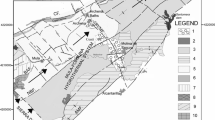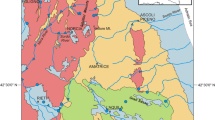Abstract
The reported study contributes to research on earthquake prediction. Between 2007 and 2009, changes were observed in two geothermal and mineral springs located in Eskipazar (∼3–5 km to the north of the North Anatolian Fault Zone) in Turkey, in relation to small-magnitude earthquakes. During pre-seismic and post-seismic activities, variations were observed in the hydrogeological parameters of the spring waters. Temperature increases of 0.4–1°C were measured in one of the springs prior to three different earthquakes. There was a slight increase in the spring discharge with respect to the first earthquake, which occurred closest to the spring. This led to a reduction in electrical conductivity (EC), total dissolved solids (TDS), Ca, HCO3, δ13C, Al, Mn, and Fe concentrations in the spring water, whereas tritium and Se values increased. Several days before the third earthquake, which occurred at a shallower depth, a decrease was observed in the discharge, which led to a reduction in tritium, δ13C and Si concentrations. These variations could be explained by changes in the mixing ratio of waters of different genesis, depending on changes in permeability, pore pressure, and flow paths of the aquifer due to regional stress changes.
Résumé
L’étude décrite contribue aux recherches sur la prédiction des séismes. Entre 2007 et 2009, des changements ont été observés dans deux champs géothermaux et sources d’eau minéral localisées à Eskipazar (∼3–5 km au nord de la zone de la faille nord Anatolienne) en Turquie, en relation avec des séismes de faible amplitude. Durant les activités pré et post-sismiques, des variations des paramètres hydrogéologiques des sources ont été observées. Une température plus élevée de 0.4–1°C a été mesurée à une des sources avant trois évènements sismiques différents. Il y a eu une légère augmentation du débit à la source au moment du premier séisme dont l’épicentre était proche de cette source. Ceci s’est traduit par une diminution de la conductivité électrique (EC), du total des éléments dissous (TDS), des concentrations en Ca, HCO3, δ13C, Al, Mn, et Fe de l’eau à la source, alors que le tritium et le Se augmentaient. Plusieurs jours avant le troisième séisme, qui a eu lieu à une plus faible profondeur, une diminution des débits a été observée, amenant une diminution du tritium, δ13C et concentration en Si. Ces variations peuvent s’expliquer par un changement dans la proportion de mélange d’eau de diverses origines, du fait de changements de la perméabilité, pression de pores et directions de flux au sein de l’aquifère en relation aux variations de stress régional.
Resumen
El estudio reportado contribuye a la investigación sobre la predicción de terremotos. Se observaron cambios entre 2007 y 2009, en dos manantiales geotermales y minerales localizados en Eskipazar (∼3–5 km al norte de la zona de falla de North Anatolian) en Turquía, relacionados a terremotos de pequeña magnitud. Durante las actividades pre sísmica y post sísmica, se observaron variaciones en los parámetros hidrogeológicos del agua de los manantiales. Se midieron incrementos de temperaturas de 0.4–1°C en uno de los manatiales antes a tres diferentes terremotos. Hubo un ligero incremento en la descarga del manantial con respecto al primer terremoto, que ocurrió en las cercanías del manantial. Este condujo a una reducción en la conductividad eléctrica (EC) y en las concentraciones de sólidos disueltos totales (TDS), Ca, HCO3, δ13C, Al, Mn, y Fe en las aguas del manantial mientras que los valores de tritio y Se se incrementaron. Varios días antes del tercer terremoto, que ocurrió a una profundidad más somera, se observó una disminución en la descarga, lo cual condujo a una reducción en las concentraciones de tritio, δ13C y Si. Estas variaciones podrían ser explicadas por cambios en la relación de mezcla de las aguas de diferentes génesis, dependiendo de los cambios en la permeabilidad, presión poral, y trayectorias de flujo del acuífero debido a los cambios de las tensiones regionales.
摘要
本文有助于地震预报研究。在2007至2009年间, 位于土耳其Eskipazar (北Anatolian断裂带北部约3–5公里) 的两个热矿泉中观测到了小震级地震引起的变化。在地震活动前后, 观测到了泉水的水文地质参数变化。三次不同的地震前, 在一眼泉中观测到了0.4–1.0°C的温度升高。最靠近该泉的第一次地震发生时, 泉的排泄量有少量增加。这引起泉水电导率 (EC)、总溶解固体 (TDS)、Ca、HCO3、δ13C、Al、Mn和Fe浓度的减少, 但氚和Se的浓度增大。在第三次地震 (震源较浅) 的前几天, 观测到了排泄量减小, 导致氚、δ13C和Si浓度的减小。这些变化可以归结为不同成因水的混合比例变化, 这取决于区域应力变化所致渗透率、孔隙压力和水流路径的变化。
Resumo
Este estudo contribui para a investigação da previsão da ocorrência de sismos. Entre 2007 e 2009 observaram-se alterações em duas fontes geotermais e minerais localizadas em Eskipazar (aprox. 3–5 km a norte da zona de falha da Anatólia do Norte), Turquia, relacionadas com sismos de baixa magnitude. Antes e após a actividade sísmica, observaram-se variações nos parâmetros hidrogeológicos de águas de nascentes. Verificou-se o aumento de 0.4–1°C na temperatura da água de uma das nascentes, antes da ocorrência de três sismos diferentes, e um ligeiro aumento dos caudais da nascente próxima do local de ocorrência do primeiro sismo. Isto conduziu a uma diminuição dos valores da condutividade elétrica (CE), dos sólidos dissolvidos totais (SDT), e das concentrações em Ca, HCO3, δ13C, Al, Mn e Fe na água da nascente, enquanto que os valores de trítio e de Se aumentaram. Vários dias antes do terceiro sismo, que ocorreu a menor profundidade, verificou-se a redução dos caudais, o que conduziu à redução das concentrações em trítio, δ13C e Si. Estas variações derivam de misturas com proporções de águas de génese diferente, dependentes de mudanças da permeabilidade, da pressão intersticial e do fluxo subterrâneo, promovidas por modificações de stress regional relacionadas com a ocorrência de sismos.








Similar content being viewed by others
References
Alan I, Aksay A (2002) 1/100.000 ölcekli Türkiye jeoloji haritaları-Zonguldak F28 paftası [1:100,000 scale geological map of Turkey-Zonguldak F28 section]. Map no. 29, Geological Research Department, MTA (General Directorate of Mineral Research and Exploration), Ankara, Turkey
Back W, Zoetl J (1975) Aplication of geochemical principles, isotopic methodology, and artifical traces to karst hydrology in hydrogeology of karst terrains. International Union of Geological Sciences, series B, no. 3, reprint from Hydrogeology of Karstic Terrains, chapter IX, IUGS Secretariat, Reston, VA, pp 105–121
Bilginer E, Pehlivan Ş, Aksay A (2002) 1/100.000 Ölçekli Türkiye Jeoloji Haritaları Bolu-G29 Paftası [1:100,000 scale geological map of Turkey-Bolu G29 section]. Map no. 36, Geological Research Department, MTA (General Directorate of Mineral Research and Exploration), Ankara, Turkey
Bolognesi L (1997) A tentative correlation between seismic activity and changes in the composition of thermal waters on Vulcano Island, Italy. Geothermics 26:379–392
Brace WF, Paulding J, Scholz C (1996) Dilatancy in the fracture of crystalline rocks. J Geophys Res 71:3939–3953
Clark ID, Fritz P (1997) Environmental isotopes in hydrogeology. Lewis, New York
Dirican A (2003) Ankara’da yağış ve su buharının çevresel izotop içeriklerinin zamanla değişiminin incelenmesi [Investigation of temporal variation of environmental isotope content in precipitation and water vapour in Ankara] (in Turkish). MSc Thesis, Hacettepe Universty, Turkey
Dobrovolsky IP, Zubkov SI, Miachkin VI (1979) Estimation of the size of earthquake preparation zones. Pure Appl Geophys 117:1025–1044
Gomberg J, Beeler NM, Blanpied ML, Bodin P (1998) Earthquake triggering by transient and static deformations. J Geophys Res 103:24411–24426
Güleç N, Hilton DR, De Leeuw GAM, Mutlu H, Süer S, Çifter C (2005) Isotope composition of geothermal fluids along the North Anatolian Fault Zone: spatial and temporal variations in relation to seismic activities. Proceedings World Geothermal Congress 2005, Antalya, Turkey, April 2005
Hamza VM (2001) Tectonic leakage of fault bounded aquifers subject to non-isothermal recharge: a mechanism generating thermal precursors to seismic events. Phys Earth Planet 126:163–177
Hartmann J (2006) Long-term seismotectonic influence on the hydrochemical composition of a spring located at Koryaksky-Volcano, Kamchatka: deduced from aggregated earthquake information. Int J Earth Sci (Geol Rundsch) 95:649–664
Hartmann J, Levy JK (2005) Hydrogeological and gasgeochemical earthquake precursors: a review for application. Nat Hazards 34:279–304
Hartmann J, Levy JK (2006) The influence of seismotectonics on precursory changes in groundwater composition for the 1995 Kobe earthquake, Japan. Hydrogeol J 14:1307–1318
Hartmann J, Berner Z, Stüben D, Henze N (2005) A statistical procedure for the analysis of seismotectonically induced hydrochemical signal: a case study from the Eastern Carpathians, Romania. Tectonophysics 405:77–98
Hill DP, Pollitz F, Newhall C (2002) Earthquake–volcano interactions. Phys Today 55:41–47
IAEA (1992) Statistical treatment of data on environmental isotopes in precipitation. Techical report series 331, IAEA, Vienna
IAEA-GNIP (2002) Global network of isotopes in precipitation, International Atomic Energy Agency, Isotope Hydrology Section. IAEA-GNIP, Vienna
Manga M, Wang CY (2007) Earthquake hydrology. In: Schubert G (ed) Treatise on geophysics, vol 4. Elsevier, Boston, MA, pp 293–320
Montgomery DR, Manga M (2003) Streamflow and water well response to earthquakes. Science 300:2047–2049
Nur A (1972) Dilatancy, pore fluids and premonitory variations of ts/tp travel times. Seismol Soc Am Bull 62:1217–1222
Nur A (1974) Matsushiro, Japan, earthquake swarm: confirmation of the dilatancy-fluid diffusion model. Geology 3:217–221
Payne B, Dinçer T (1965) Isotope survey of karst region of southern Turkey. Proceedings of 6th International Conference of radiocarbon and Tritium Dating, no. 620652, IAEA, Vienna
Sayin M, Eyüpoğlu SÖ (2005) Türkiyedeki yağışların kararlı izotop içeriklerini kullanarak yerel meteorik doğruların belirlenmesi [Determination of the local meteoric water lines using stable isotope contents of precipitation in Turkey]. II. Ulusal Hidrolojide İzotop Teknikleri Sempozyumu [Second National Symposium on Isotope Technics in Hydrology]. Izmir, Turkey, September 2005
Scholz CH, Sykes LR, Aggarwal YP (1973) Earthquake prediction: a physical basis. Science 181:803–810
Sevin M, Aksay A (2002) 1/100.000 Ölçekli Türkiye Jeoloji Haritaları Bolu-G28 Paftası [1:100,000 scale geological map of Turkey-Bolu G28 section]. Map no. 35, Geological Research Department, MTA (General Directorate of Mineral Research and Exploration), Ankara, Turkey
Süer S, Güleç N, Mutlu H, Çifter C, Sayin M, Hilton DR (2005) Sismik etkinliklerin izlenmesinde hidrojeokimyasal ve izotopik parametreler: Kuzey Anadolu Fay Zonu [Hdrogeochemical and isotopic componets in tracing of seismic activities]. II. Ulusal Hidrolojide İzotop Teknikleri Sempozyumu [Second National Symposium on Isotope Technics in Hydrology], Izmir, Turkey, September 2005
Süer S, Güleç N, Mutlu H, Hilton DR, Çifter C, Sayın M (2008) Geochemical monitoring of geothermal waters (2002–2004) along the North Anatolian Fault Zone, Turkey: spatial and temporal variation and relationship to seismic activity. Pure Appl Geophys 165:17–43
Şaroğlu F, Herece E, Sarıaslan M, Emre Ö (1995) Yeniçağa-Eskipazar-Gerede arasının jeolojisi ve Kuzey Anadolu Fayı’nın genel özellikleri [Geology of the Eskipazar-Gerede region and general features of North Anatolian Fault Zone]. MTA report no. 9873, MTA, Ankara, Turkey
Şimşek Ş, Yildirim N (2000) Geothermal activity at 17 August and 12 November 1999 Eastern Marmara Earthquake Region, Turkey. IGA meeting, Antalya, Turkey, March 2000, pp 1–9
Thomas D (1988) Geochemical precursors to seismic activity. Pure Appl Geophys 126:241–266
Timur E, Aksay A (2002) 1/100.000 Ölçekli Türkiye Jeoloji Haritaları Zonguldak-F29 Paftası [1:100,000 scale geological map of Turkey-Zonguldak F29 section]. Map no. 30, Geological Research Department, MTA (General Directorate of Mineral Research and Exploration), Ankara, Turkey
Tokay M (1973) Kuzey Anadolu Fay Zonunun Gerede ile Ilgaz arasındaki kısmında jeolojik gözlemler [Geological observations on the North Anatolian Fault Zone in the area between Gerede Ilgaz]. Kuzey Anadolu Fayı ve Deprem Kuşağı Simpozyumu [Symposium on The North Anatolian Fault and Earthquake Belt], MTA Institute, Ankara, Turkey, pp 12–29
Toutain JP, Baubron JC (1999) Gas geochemistry and seismotectonics: a review. Tectonophysics 304:1–27
Acknowledgements
The authors would like to thank Cumhuriyet University Scientific Research Projects Commission (CÜBAP) and Eskipazar Municipal authorities and workers for providing financial and in-field study support. The author is also very grateful for the significant and constructive comments of the reviewers and the editors.
Author information
Authors and Affiliations
Corresponding author
Electronic supplementary materials
Below is the link to the electronic supplementary material.
Rights and permissions
About this article
Cite this article
Ekemen Keskin, T. Groundwater changes in relation to seismic activity: a case study from Eskipazar (Karabuk, Turkey). Hydrogeol J 18, 1205–1218 (2010). https://doi.org/10.1007/s10040-010-0589-x
Received:
Accepted:
Published:
Issue Date:
DOI: https://doi.org/10.1007/s10040-010-0589-x




